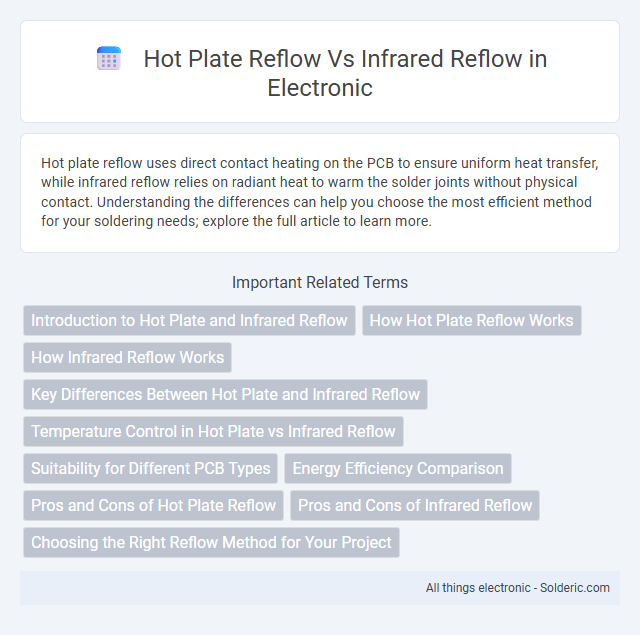Hot plate reflow uses direct contact heating on the PCB to ensure uniform heat transfer, while infrared reflow relies on radiant heat to warm the solder joints without physical contact. Understanding the differences can help you choose the most efficient method for your soldering needs; explore the full article to learn more.
Comparison Table
| Feature | Hot Plate Reflow | Infrared Reflow |
|---|---|---|
| Heat Source | Direct contact heating via hot plates | Radiant infrared energy |
| Heating Uniformity | Moderate, depends on plate consistency | High, evenly distributed IR radiation |
| Temperature Control | Precise localized control | Precise but affected by PCB material |
| Heating Speed | Slower due to conduction | Faster due to direct radiation |
| Suitable PCB Types | Thick or multilayer PCBs | Thin or single-layer PCBs |
| Cost | Generally lower setup cost | Higher initial equipment cost |
| Process Complexity | Simple setup, less sensitive to PCB design | Requires careful calibration |
| Thermal Stress | Lower risk due to gradual heating | Higher risk, potential hotspots |
Introduction to Hot Plate and Infrared Reflow
Hot plate reflow utilizes a heated surface to solder components by directly applying heat to the PCB, offering precise temperature control and uniform heat distribution. Infrared reflow employs radiant energy to heat components and solder paste simultaneously, enabling rapid and efficient soldering with minimal thermal mass influence. Your choice between these methods depends on factors like board complexity, component sensitivity, and production volume.
How Hot Plate Reflow Works
Hot plate reflow operates by placing the printed circuit board (PCB) directly on a heated metal plate, which transfers heat evenly through conduction to melt the solder paste and create reliable solder joints. This method enables precise temperature control, essential for preventing thermal damage to sensitive components during reflow soldering. Understanding how hot plate reflow works allows you to optimize your soldering process for consistent quality and efficiency in small to medium batch PCB assembly.
How Infrared Reflow Works
Infrared reflow soldering works by emitting infrared radiation to heat solder paste and electronic components directly and uniformly on a PCB, enabling precise temperature control. This radiative heat transfer efficiently penetrates components, providing rapid, localized heating that minimizes thermal stress and reduces the risk of damage. Compared to hot plate reflow, infrared reflow offers superior uniformity and process control, making it ideal for delicate and complex assemblies.
Key Differences Between Hot Plate and Infrared Reflow
Hot plate reflow uses direct conduction heat transfer by placing the PCB on a heated surface, offering precise temperature control and uniform heating ideal for small-scale soldering. Infrared reflow relies on radiation heat transfer, where infrared lamps emit energy absorbed by the PCB and components, enabling faster heating cycles suitable for mass production. Your choice depends on factors like component sensitivity, production volume, and required temperature accuracy.
Temperature Control in Hot Plate vs Infrared Reflow
Hot plate reflow provides precise temperature control by directly heating the PCB through conduction, allowing for accurate and uniform temperature distribution critical for sensitive components. Infrared reflow relies on radiant heat, which can result in uneven temperature profiles due to varying absorption rates of materials, potentially causing overheating or insufficient solder melting. Your choice should consider the importance of uniform temperature control to ensure optimal solder joint quality and minimize thermal stress.
Suitability for Different PCB Types
Hot plate reflow excels with small-to-medium sized PCBs that require precise temperature control and uniform heat distribution, making it ideal for delicate or complex assemblies. Infrared reflow suits a wider range of PCB types, including larger or double-sided boards, due to its ability to apply targeted, rapid heat and penetrate components effectively. Each method offers distinct thermal profiles that influence solder joint quality and component reliability based on PCB material and layout complexity.
Energy Efficiency Comparison
Hot plate reflow systems generally consume less energy by directly heating the substrate, resulting in reduced heat loss compared to infrared reflow ovens that radiate heat and may experience energy dissipation through ambient air. Infrared reflow requires higher power to maintain uniform temperature distribution over larger areas, increasing overall energy consumption. Optimizing thermal conductivity in hot plate setups enhances energy efficiency, making them more cost-effective and environmentally friendly for small-batch soldering processes.
Pros and Cons of Hot Plate Reflow
Hot plate reflow offers precise temperature control and uniform heating, making it ideal for small-scale or prototype soldering tasks; it also provides quick setup and is cost-effective for limited production runs. However, this method can suffer from slower heating rates compared to infrared reflow and may have difficulty accommodating complex or large boards evenly. Your choice depends on balancing the need for precision with throughput speed and the scale of your manufacturing process.
Pros and Cons of Infrared Reflow
Infrared reflow offers precise temperature control and uniform heat distribution, making it ideal for small to medium-sized PCB assemblies. However, it may cause uneven heating in components with varying thermal masses, potentially leading to solder joint defects. Your production efficiency can improve with infrared reflow, but it requires careful calibration to avoid damage to sensitive components.
Choosing the Right Reflow Method for Your Project
Hot plate reflow offers precise temperature control and localized heating, making it ideal for small to medium-sized assemblies or prototypes. Infrared reflow provides uniform heat distribution suitable for complex multi-layer boards and high-volume production runs. Selecting the right reflow method depends on your project's scale, component sensitivity, and required thermal profiles to ensure optimal soldering quality and device reliability.
hot plate reflow vs infrared reflow Infographic

 solderic.com
solderic.com